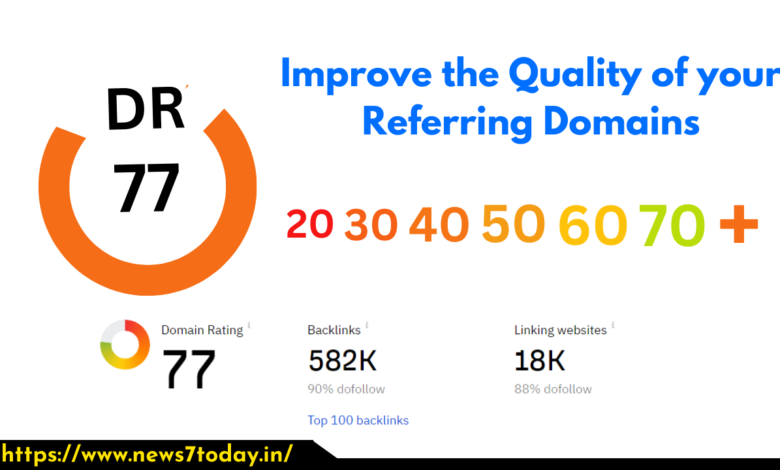Best Guide: What is a Referring Domain

A referring domain is the source website that links to another website. It refers to the domain name of the website that contains a link that sends a user to another website. The number of referring domains to your website is a factor used by search engines to determine the popularity and authority of your website. A high number of high-quality referring domains can improve your website’s search engine visibility, ranking, and credibility.
What is a Referring Domain
A referring domain is a website that sends traffic to another website through a link. The referring domain is the source of the referral traffic and is used to track the origin of a website’s visitors. In other words, a referring domain acts as a recommendation for your website, and the more recommendations you have from reputable sources, the more authoritative and trustworthy your website appears to search engines and users.
Difference Between Backlinks and Referring Domains
Backlinks and referring domains are two important metrics in the world of search engine optimization (SEO). While they are often used interchangeably, they are two distinct concepts with different implications for a website’s search engine ranking.
A backlink is a link from one website to another. In the context of SEO, backlinks are considered a “vote of confidence” in the linking website’s eyes, indicating that the linked-to website has valuable content. The more backlinks a website has, the higher its search engine ranking is likely to be.
A referring domain, on the other hand, is the domain name of the website that contains the backlink. So, if a website has 10 backlinks from the same referring domains, it would only be counted as one referring domain. The number of referring domains that link to a website is a key indicator of its authority and credibility in the eyes of search engines.
It is important to understand that not all backlinks are created equal. A backlink from a highly authoritative website carries more weight in terms of SEO value than a backlink from a lower-quality website. The same is true for referring domains: a backlink from a reputable, high-traffic website is much more valuable than a backlink from a lesser-known website.
While backlinks and referring domains are closely related, they are not the same thing. Backlinks are individual links that lead to a website, while referring domains are the sources of those links. Both metrics are important for SEO, and a well-rounded SEO strategy should focus on both building high-quality backlinks and increasing the number of reputable referring domains that link to a website.
How to Track Referring Domains
Tracking referring domains is an important part of any website’s search engine optimization (SEO) strategy. It provides valuable insight into where your website’s traffic is coming from, which can help you make informed decisions about your SEO efforts. In this post, we’ll explore some of the best ways to track referring domains and make the most of the information they provide.
Google Analytics – Google Analytics is a powerful tool for website owners and marketers. It provides detailed information about a website’s traffic, including the sources of that traffic. To view the referring domains that are sending traffic to your website, simply log in to your Google Analytics account, navigate to the “Acquisition” section, and then click on “Referral.” Here, you’ll see a list of the domains that are referring visitors to your website, along with the number of visitors they are sending.
SEMrush – SEMrush is a popular SEO tool that provides a wide range of features, including the ability to track referring domains. Simply log in to your SEMrush account and go to the “Backlinks” section. From here, you can view a list of the domains that are linking to your website, along with information about the quality of each link.
Ahrefs – Ahrefs is another popular SEO tool that provides a wealth of information about a website’s backlinks and referring domains. To view your referring domains in Ahrefs, log in to your account and navigate to the “Backlinks” section. From here, you can view a list of the domains that are linking to your website, along with information about the quality and quantity of each link.
Majestic – Majestic is another SEO tool that provides detailed information about a website’s backlinks and referring domains. To view your referring domains in Majestic, log in to your account and go to the “Backlink History” section. From here, you can view a list of the domains that are linking to your website, along with information about the quality and quantity of each link.
Tracking referring domains is an important part of any website’s SEO strategy. By using tools like Google Analytics, SEMrush, Ahrefs, and Majestic, you can gain valuable insight into where your website’s traffic is coming from, which can help you make informed decisions about your SEO efforts. Whether you’re a seasoned SEO professional or just getting started, tracking referring domains is an essential step toward optimizing your website for search engines and driving more traffic to your site.
How to Improve the Quality of your Referring Domains
Having high-quality referring domains is crucial for a website’s search engine optimization (SEO) and overall online success. Referring domains, also known as backlinks, link from other websites that point to your website. The quality of these backlinks is a major factor in determining a website’s ranking in search engine results pages (SERPs).
Create high-quality content – The first step towards attracting high-quality backlinks is to create valuable and informative content that people want to link to. This can include blog posts, videos, infographics, and other types of content that provide value to your target audience. The more valuable your content is, the more likely other websites will be to link to it.
Reach out to influencers in your niche – Building relationships with influencers in your niche can be a great way to get high-quality backlinks. By reaching out to influencers and offering them something of value, such as guest blogging opportunities or exclusive access to your latest research, you can establish a mutually beneficial relationship that will help you improve the quality of your backlinks.
Participate in relevant online communities – Participating in online communities related to your niche is another great way to improve the quality of your backlinks. By offering valuable insights and engaging in meaningful conversations, you can establish yourself as an authority in your niche and attract backlinks from other relevant websites.
Utilize guest posting – Guest posting is a great way to get high-quality backlinks from other websites. By writing valuable and informative content for other websites in your niche, you can establish yourself as an expert in your field and attract backlinks from websites that are relevant to your own.
Monitor your backlinks – Regularly monitoring your backlinks is crucial for maintaining the quality of your referring domains. By using tools like Google Analytics, SEMrush, Ahrefs, and Majestic, you can see which domains are linking to your website and check the quality of each link. If you find any low-quality links, you can take steps to remove them and improve the overall quality of your backlinks.
Improving the quality of your referring domains is crucial for a website’s SEO and overall online success. By creating valuable and informative content, reaching out to influencers in your niche, participating in relevant online communities, utilizing guest posting, and regularly monitoring your backlinks, you can improve the quality of your referring domains and maximize the benefits they provide.
Conclusion
A conclusion referring domain refers to the source or origin of a link that directs to a website or a web page. The referring domains can provide insights into the source of the traffic to a website, as well as the credibility and relevance of the linking site. Understanding the referring domains can help website owners and marketers to improve their search engine optimization (SEO) efforts and increase their online visibility.
Frequently Asked Questions
Q: How does a referring domain affect SEO?
The quality and relevance of the referring domains can impact a website’s search engine ranking. High-quality referring domains can increase a website’s visibility and credibility, while a low-quality referring domain can have a negative impact on search engine rankings.
Q: How can I see my referring domains?
Referring domains can be viewed through web analytics tools such as Google Analytics or through server log files.
Q: Are all referring domains equal in terms of their impact on SEO?
No, the impact of referring domains on SEO can vary based on the quality, relevance, and authority of the linking site.
Q: How can I improve my referring domains?
Improving referring domains can be done by creating high-quality content, building relationships with other websites, and promoting your content through various channels.
Also Read – How Can Get Google to Crawl Your Website Instantly
How to Start a Blog and Earn Money from It 2023
What is GAP Insurance How does it work in 2023
How to Get Cheap Car Insurance – Tips and Discounts










4 Comments